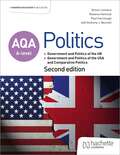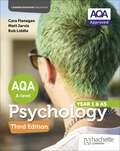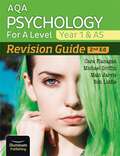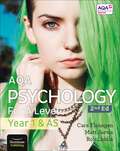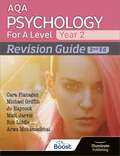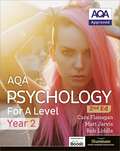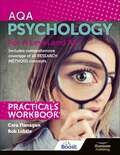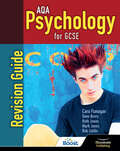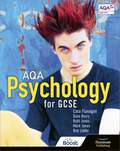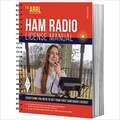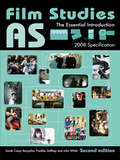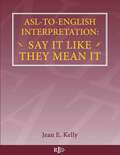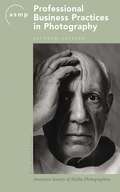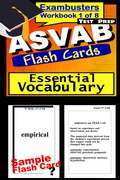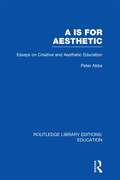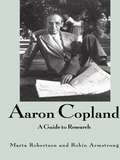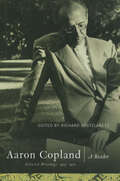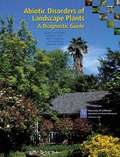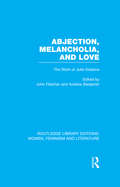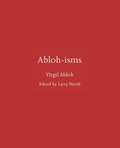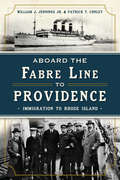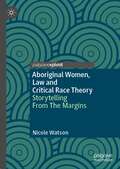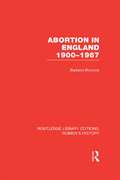- Table View
- List View
AQA A-level Politics: Government and Politics of the UK, Government and Politics of the USA and Comparative Politics Second Edition
by Simon Lemieux Anthony J Bennett Paul Fairclough Rowena HammalThe only textbook specifically designed to cover AQA A-level Politics for Paper 1 and Paper 2, focusing on the Government and Politics of the UK, the Government and Politics of the USA, and Comparative Politics. This second edition has been created by a trusted team of experts and is designed to help your students achieve success in A-level Politics by:┒ Putting politics in context with real-world case studies, insights into contemporary issues and analysis of the latest developments in UK and US Politics, including the 2024 UK General Election and 2024 US election┒ Enhancing analytical and evaluative skills through engaging activities and debates┒ Providing opportunities for exam practice and boost students' confidence through exam-style questions┒ Clearly highlighting key terms, core concepts, and connections across topics in the AQA specification.┒ Finding answer guidance for practice questions at www.hachettelearning.com.
AQA Psychology for A Level : Year 1 and AS Third edition
by Cara Flanagan Matt Jarvis Rob LiddleApproved by AQAThoroughly revised and updated to match the latest AQA A-level Psychology specification, this highly visual and engaging Student Book will support students through the AS/Year 1 course and help them thoroughly prepare for their exams.-All chapters thoroughly revised to match the new specification, and content reviewed and refreshed to bring it up to date-Updated evaluation material uses a three-paragraph structure (point, evidence and conclusion) and includes counterpoints to develop discussion skills- The new edition retains the popular spread-based approach that students know and love, with a clear and accessible layout to help them engage with and absorb the information- Each topic is presented on one spread so students can instantly see the whole picture with description and evaluation clearly separated- Mathematical and research methods requirements are thoroughly covered with new practice questions and new ideas for research activities in each chapter- Lots of recent research ensures the content is up to date- 'Apply it' activities provide plenty of opportunities to practise application skills- Visual summaries of each chapter help ensure a good grasp of the basics- Exam practice, example student answers and skills guidance are providedWritten by leading psychology authors, Cara Flanagan, Matt Jarvis and Rob Liddle and approved by AQA, providing high quality support you can trust.
AQA Psychology for A Level Year 1 & AS Revision Guide: 2nd Edition
by Michael Griffin Cara Flanagan Matt Jarvis Rob LiddleA 2nd Edition of this incredibly popular revision guide, this portable-sized book is ideal for consolidating knowledge both at home for revision, and at school as a lesson-by-lesson summary as the course progresses. // AO1 Description on the left-hand page: content divided into six points for six AO1 marks in extended writing questions. // AO3 Evaluation is on the right-hand page: three AO3 points plus counterpoint and extra evaluation (discussion) point. // Exam practice questions, including AO2 application questions, are on every spread providing lots of practice. // Research studies have been simplified to help revise and recall the information. // Detailed exam advice section is included, with hints and tips offered throughout the book. // Lots of illustrations and the odd corny joke help make it very user-friendly! // It combines brilliantly with the 'Green-hair Girl' 2nd Edition Flashbook as well as the original (and still completely relevant) Revision App.
AQA Psychology for A Level Year 1 & AS Student Book: 2nd Edition
by Cara Flanagan Matt Jarvis Rob LiddleApproved by AQA and written by leading psychology authors, Cara Flanagan, Matt Jarvis and Rob Liddle, the 2nd Edition of this popular Student Book will support you through the AS / Year 1 course and help you thoroughly prepare for your exams. // Approved by AQA, this book offers high quality support you can trust. // The clear and accessible layout will help you engage with and absorb the information. // Each topic is presented on one spread to see the whole picture with description and evaluation clearly separated. // Evaluation material uses a three-paragraph structure (point, evidence and conclusion) and includes counterpoints to develop discussion skills. // 'Apply it' activities provide plenty of opportunities to practise application skills. // Mathematics and research methods requirements are thoroughly covered with practice questions on most spreads and ideas for research activities in each chapter. // Visual summaries of each chapter help ensure a good grasp of the basics. // Exam practice, example student answers and skills guidance are provided. // For invaluable revision support it combines brilliantly with the 'Green-hair Girl' 2nd Edition Revision Guide and Flashbook as well as the original (and still completely relevant) Revision App.
AQA Psychology for A Level Year 2 Revision Guide: 2nd Edition
by Michael Griffin Cara Flanagan Matt Jarvis Rob Liddle Jo Haycock Arwa MohamedbhaiA 2nd Edition of this incredibly popular revision guide, this portable-sized book is ideal for consolidating knowledge both at home for revision, and at school as a lesson-by-lesson summary as the course progresses. // AO1 Description on the left-hand page: content divided into six points for six AO1 marks in extended writing questions. // AO3 Evaluation is on the right-hand page: three AO3 points plus counterpoint and extra evaluation (discussion) point. // Exam practice questions, including AO2 application questions, are on every spread providing lots of practice. // Research studies have been simplified to help revise and recall the information. // Detailed exam advice section is included, with hints and tips offered throughout the book. // Lots of illustrations and the odd corny joke help make it very user-friendly! // It combines brilliantly with the 'Pink-hair Girl' 2nd Edition Flashbook as well as the original (and still completely relevant) Revision App.
AQA Psychology for A Level Year 2 Student Book: 2nd Edition
by Cara Flanagan Matt Jarvis Rob LiddleApproved by AQA and written by leading psychology authors, Cara Flanagan, Matt Jarvis and Rob Liddle, the 2nd Edition of this popular Student Book will support you through the A Level Year 2 course and help you thoroughly prepare for your exams. // Approved by AQA, this book offers high quality support you can trust. // The clear and accessible layout will help you engage with and absorb the information. // Each topic is presented on one spread to see the whole picture with description and evaluation clearly separated. // Evaluation material uses a three-paragraph structure (point, evidence and conclusion) and includes counterpoints to develop discussion skills. // 'Apply it' activities provide plenty of opportunities to practise application skills. // Mathematics and research methods requirements are thoroughly covered with practice questions on most spreads and ideas for research activities in each chapter. // Visual summaries of each chapter help ensure a good grasp of the basics. // Exam practice, example student answers and skills guidance are provided. // For invaluable revision support it combines brilliantly with the 'Pink-hair Girl' 2nd Edition Revision Guide and Flashbook as well as the original (and still completely relevant) Revision App.
AQA Psychology for A Level and AS - Practicals Workbook
by Cara Flanagan Rob LiddleDid you know that research methods content is worth at least 25% of your final exam mark? That's more than three times as much as any other topic.This new workbook provides full coverage of the AQA specification for research methods along with practical activities to help you properly understand what research methods are all about.- Includes clear explanations of all research methods topics, including strengths and weaknesses.- Based on the principle of 'doing', each content spread is followed by a related practical to complete in class and/or for homework.- The workbook uses a spiral curriculum - revisiting topics so you can pick up a deeper understanding each time.- Exam-style questions and MCQs help you assess your knowledge.- Tips are given for 'top marks', based on what examiners are looking for in answers.- Links are provided to specification-related psychological studies covered in our best-selling AQA Psychology student books.
AQA Psychology for GCSE: Revision Guide
by Cara Flanagan Dave Berry Rob Liddle Mark Jones Ruth JonesWritten by Cara Flanagan and a highly experienced author team, this Revision Guide provides everything students need to know for their exams. // All the essential content for one topic - description and evaluation on one spread. // Invaluable exam tips. // `Apply it' questions allow students to apply their knowledge to a scenario question - some 'Apply it' questions focus on research methods. // `Knowledge check' questions are typical exam-style questions for that topic. // Suggested answers for 'Apply it' and 'Knowledge check' questions are provided as a free downloadable file. // Activities on every topic to improve exam skills and performance. // Two `write-in' activities on each topic help students practise and process the information on that topic. // All the activities are designed to help students correctly interpret and answer the exam questions. // Suggested answers for all the activities are provided as a free downloadable file.
AQA Psychology for GCSE: Student Book
by Cara Flanagan Dave Berry Rob Liddle Mark Jones Ruth JonesWritten by renowned author Cara Flanagan and a highly experienced author team, this Student Book has been approved by AQA, offering high quality support you can trust. // Each topic in the specification is presented on one spread so you can see the whole topic with just the right amount of detail and depth of information. // Spreads are divided into Description (AO1) and Evaluation (AO3) - the two key skills for any topic. // Research methods and mathematical requirements are thoroughly covered in a dedicated chapter plus in 'Apply it' exercises across the book. // Application questions, practice questions and skills guidance are provided for the new assessment objectives and mark schemes. // Each chapter ends with visual summaries, example student answers with comments and test yourself multiple choice questions.
AQA Psychology for GCSE: Student Book
by Cara Flanagan Dave Berry Rob Liddle Mark Jones Ruth JonesWritten by renowned author Cara Flanagan and a highly experienced author team, this Student Book has been approved by AQA, offering high quality support you can trust. // Each topic in the specification is presented on one spread so you can see the whole topic with just the right amount of detail and depth of information. // Spreads are divided into Description (AO1) and Evaluation (AO3) - the two key skills for any topic. // Research methods and mathematical requirements are thoroughly covered in a dedicated chapter plus in 'Apply it' exercises across the book. // Application questions, practice questions and skills guidance are provided for the new assessment objectives and mark schemes. // Each chapter ends with visual summaries, example student answers with comments and test yourself multiple choice questions.
ARRL Ham Radio License Manual
by Arrl Inc.Everything You Need to Get Your First Ham Radio License! The ARRL Ham Radio License Manual will help you discover all the excitement of ham radio. It has easy-to-understand "bite-sized" sections to help you get started. From understanding the rules and regulations to selecting your equipment, setting up your first station, and making your first contact! Plus, it's an excellent reference as you advance your interest in radio communications. Filled with all the information you need to pass the Technician class exam, including: Amateur Radio Rules and Activities Radio and Signals Fundamentals Electricity, Components, and Circuits Propagation, Antennas, and Feed Lines Amateur Radio Equipment Communicating with Other Hams Licensing Regulations Operating Regulations Electrical and Mechanical Safety ARRL's best-selling study guide features all the questions and answers, with detailed explanations, for examinations taken through June 30, 2026. Use it to study for the 35-question exam and there will be no surprises on exam day! Hams experiment with technology and electronics, serve the public through emergency communications, and enjoy talking to people across the country and around the world. Portable transceivers allow you to get on the air anywhere, from a park bench to a roving SUV, to a mountaintop, and more! With a Technician class license, any ham can contact the International Space Station, measure the reach of their signal with propagation beacons, or connect with others via satellite. The ARRL Ham Radio License Manual will help you get licensed on the air!
AS Film Studies: The Essential Introduction
by John White Freddie Gaffney Sarah Casey BenyahiaAS Film Studies: The Essential Introduction gives students the confidence to tackle every part of the WJEC AS level Film Studies course. The authors, who have wide ranging experience as teachers, examiners and authors, introduce students step by step, to the skills involved in the study of film. The second edition follows the new WJEC syllabus for 2008 teaching onwards and has a companion website with additional resources for students and teachers. Specifically designed to be user friendly, the second edition of AS Film Studies: The Essential Introduction has a new text design to make the book easy to follow, includes more than 100 colour photographs and is jam packed with features such as: Case studies relevant to the 2008 specification Activities on films including Little Miss Sunshine, Pirates of the Caribbean & The Descent Key terms Example exam questions Suggestions for further reading and website resources
ASL-To-English Interpretation: Say It Like They Mean It
by Jean Elaine KellyThe focus of ASL to English: Say it Like They Mean It, is not about how we, the interpreters, think the English interpretation should be presented, but rather, how would an English speaking consumer with no understanding of Deaf Culture best understand the voiced message. The task of producing an appropriate interpretation from ASL to English is often noted as being the more difficult of the two interpreting tasks. With only two years in most interpreter education programs, students may not have a full comprehension of what is expected in ASL to English interpretation.This book looks at difficulties and issues that can arise as interpreters work between ASL and English, with exercises at the end of every chapter. ASL to English Interpretation: Say It Like They Mean It will not only give students currently studying interpreting an opportunity to learn how to interpret from ASL to English, but will also give students the opportunity to discuss and work on the task of the English interpretation with their teacher and fellow students.This book is identical to ISBN 0-916883-38-8, it is just perfect-bound instead of spiral-bound, which required a new ISBN.
ASMP Professional Business Practices in Photography
by American Society of Media PhotographersAt last! The eagerly anticipated revised edition of the photographer's "business bible" is here, fully updated with the last word on key business practices, industry standards, and resources. Up-to-the-minute coverage now includes digital asset management; metadata standards; the role of Internet, FTP, and e-mail technologies; the impact of media consolidation on assignment and stock photography; and much more. This indispensable guide covers the full range of business and legal questions that photographers might have, with comprehensive advice from the ASMP, the foremost authority in the field. In eleven in-depth chapters, more than two dozen industry experts explore pricing and negotiating, ethics, rights in traditional and electronic media, publishing, and much more. Business and legal forms, checklists, and an extensive cross-media bibliography make this the one reference book that deserves a place on every successful photographer's bookshelf.
ASVAB Test Prep Flash Cards: Essential Vocabulary (Exambusters ASVAB Workbook #1 of 8)
by Ace Inc.<P><P><i>Advisory: Bookshare has learned that this book offers only partial accessibility. We have kept it in the collection because it is useful for some of our members. Benetech is actively working on projects to improve accessibility issues such as these.</i><P><P> 500 frequently tested ASVAB words every high school student should know. Perfect for anyone who wants to enrich their vocabulary! Improve your reading comprehension and conversation. <P><P>Includes sample sentence, part of speech, pronunciation, succinct, easy-to-remember definition, and common synonyms and antonyms. <P>EXAMBUSTERS ASVAB Prep Workbooks provide comprehensive, fundamental ASVAB review--one fact at a time--to prepare students to take practice ASVAB tests. Each ASVAB study guide focuses on one specific subject area covered on the ASVAB exam. From 300 to 600 questions and answers, each volume in the ASVAB series is a quick and easy, focused read. Reviewing ASVAB flash cards is the first step toward more confident ASVAB preparation and ultimately, higher ASVAB exam scores!
Aa is for Aesthetic: Essays on Creative and Aesthetic Education (Routledge Library Editions: Education)
by Peter AbbsThis volume reaffirms the indispensable place of the arts in any coherent curriculum. The author hopes that the specific arguments formulated in the book will advance the conservationist post-Modernist aesthetic.
Aaron Copland: A Guide to Research (Routledge Music Bibliographies)
by Marta Robertson Robin ArmstrongAaron Copland (1900-1990) is generally considered the most popular and well-known composer of American art music, and yet little scholarly attention has been paid to Copland since the 1950s. This volume begins with a portrait of the composer and an evaluation of significant research trends which is intended to fill a void and to suggest directions for further research. The guide also provides a section discussing Copland's interdisciplinary interests, such as ballet and film work, as well as a comprehensive bibliography of writings about Copland and his music.
Aaron Copland: A Reader: Selected Writings, 1923-1972
by Richard Kostelanetz Steve SilversteinThis book presents a selection of the best writings, of the American composer and music legend Aaron Copland, on a wide variety of topics. It features excerpts from his correspondence and recommendations he wrote for other composers.
Abandoned Malls of America: Crumbling Commerce Left Behind
by Seph LawlessWhat happens when the symbol of commerce crumbles? This collection of nearly two hundred stunning yet melancholic photos captures the decline of one of the biggest symbols of American consumerism—the shopping mall. Seph Lawless, whom Huffington Post refers to as the &“master of the abandoned,&” details the dilapidated state of these buildings that were once thriving with people and merchandise, now left to rot and be overrun with plant and animal life. In Abandoned Malls of America, Lawless showcases haunting images of shopping malls from all across America, from his hometown of Cleveland, OH in the Midwest to Birmingham, AL in the South and all the way to Los Angeles, CA on the West Coast. Alongside these beautiful images are first-hand accounts from people who grew up going to these malls, reminiscing on the dually wistful and fond memories of their once-favorite local hangouts. These essays include anecdotes from actress Yvette Nicole Brown (Drake and Josh; Community; etc.), actor Justin Kucsulain (The Walking Dead), New Yorker investigative journalist Ronan Farrow, and more. In this follow-up to his previous book, Abandoned, &“artivist&” Seph Lawless continues his journey photo-documenting the America left behind in the throes of economic instability and overall decline. Abandoned Malls of America is a perfect read for those interested in photography, architecture, or just longing for a little bit of nostalgia.
Abiotic Disorders of Landscape Plants: A Diagnostic Guide
by Laurence R. Costello Edward J. Perry Nelda P. Matheny J. Michael Henry Pamela M. GeiselLandscape plants can be injured by biotic and abiotic agents. This book focuses on abiotic disorders such as water deficits, aeration deficits, nutritional deficiencies, specific ion toxicities, pH-related problems, and herbicide injury.
Abjection, Melancholia and Love: The Work of Julia Kristeva (Routledge Library Editions: Women, Feminism and Literature)
by John Fletcher Andrew BenjaminThis volume begins with a new essay by Julia Kristeva, ‘The Adolescent Novel’, in which she examines the relation between novelistic writing and the experience of adolescence as an ‘open structure’. It is this blend of the literary with the psychoanalytic that places Kristeva’s work central to current thinking, from semiotics and critical theory to feminism and psychoanalysis. The essays in this volume offer insight into the workings of Kristeva’s thought, ranging from her analyses of sexual difference, female temporality and the perceptions of the body to the mental states of abjection and melancholia, and their representation in painting and literature. Kristeva’s persistent humanity, her profound understanding of the dynamics of intention and creativity, mark her out as one of the leading theoreticians of desire. Each essay offers the reader a new insight into the many aspects that make up Kristeva’s entire oeuvre.
Abloh-isms (ISMs)
by Virgil AblohA collection of essential quotations from the renowned fashion designer, DJ, and stylistAbloh-isms is a collection of essential quotations from American fashion designer, DJ, and stylist Virgil Abloh, who has established himself as a major creative figure in the worlds of pop culture and art. Abloh began his career as Kanye West’s creative director before founding the luxury streetwear label Off-White and becoming artistic director for Louis Vuitton, making Abloh the first American of African descent to hold that title at a French fashion house. Defying categorization, Abloh’s work has been the subject of solo exhibitions at museums and galleries, most notably in a major retrospective at the Museum of Contemporary Art Chicago. Gathered from interviews and other sources, this selection of compelling and memorable quotations from the designer reveals his thoughts on a wide range of subjects, including creativity, passion, innovation, race, and what it means to be an artist of his generation. Lively and thought-provoking, these quotes reflect Abloh’s unique perspective as a trailblazer in his fields.Select quotations from the book:“I believe that coincidence is key, but coincidence is energies coming towards each other. You have to be moving to meet it.”“Life is collaboration. Where I think art can be sort of misguided is that it propagates this idea of itself as a solo love affair—one person, one idea, no one else involved.”“Black influence has created a new ecosystem, which can grow and support different types of life that we couldn’t before.”“Like it or not, irrelevance is death.”
Aboard the Fabre Line to Providence: Immigration to Rhode Island
by Patrick T. Conley William J. Jennings Jr.In an era when immigration was at its peak, the Fabre Line offered the only transatlantic route to southern New England. One of its most important ports was in Providence, Rhode Island. Nearly eighty-four thousand immigrants were admitted to the country between the years 1911 and 1934. Almost one in nine of these individuals elected to settle in Rhode Island after landing in Providence, amounting to around eleven thousand new residents. Most of these immigrants were from Portugal and Italy, and the Fabre Line kept up a brisk and successful business. However, both the line and the families hoping for a new life faced major obstacles in the form of World War I, the immigration restriction laws of the 1920s, and the Great Depression. Join authors Patrick T. Conley and William J. Jennings Jr. as they chronicle the history of the Fabre Line and its role in bringing new residents to the Ocean State.
Aboriginal Women, Law and Critical Race Theory: Storytelling From The Margins (Palgrave Studies in Race, Ethnicity, Indigeneity and Criminal Justice)
by Nicole WatsonThis book explores storytelling as an innovative means of improving understanding of Indigenous people and their histories and struggles including with the law. It uses the Critical Race Theory (‘CRT’) tool of ‘outsider’ or ‘counter’ storytelling to illuminate the practices that have been used by generations of Aboriginal women to create an outlaw culture and to resist their invisibility to law. Legal scholars are yet to use storytelling to bring the experiential knowledge of Aboriginal women to the centre of legal scholarship and yet this book demonstrates how this can be done by way of a new methodology that combines elements of CRT with speculative biography. In one chapter, the author tells the imagined story of Eliza Woree who featured prominently in the backdrop to the decision of the Supreme Court of Queensland in Dempsey v Rigg (1914) but whose voice was erased from the judgements. This accessible book adds a new and innovative dimension to the use of CRT to examine the nexus between race and settler colonialism. It speaks to those interested in Indigenous peoples and the law, Indigenous studies, Indigenous policy, Aboriginal and Torres Strait Islander history, feminist studies, race and the law, and cultural studies.
Abortion in England 1900-1967 (Routledge Library Editions: Women's History)
by Barbara BrookesOver the decades from 1900 to 1967 abortion was transformed from an important female-centred form of fertility control into a medical event, closely monitored by the State. This transition, the author argues here, took place against a background of debate over fertility control and its implications for women’s maternal role. The book, originally published in 1988, suggests that the inter-war years saw a crucial mapping of boundaries in the debates over abortion. The distinction between methods of fertility control used before and after conception was more sharply drawn. The abortion law was difficult to enforce and in 1936 the Abortion Law Reform Association was founded by feminists to call for safe legal abortion as a woman’s right. Resort to criminal abortion continued in the post-war years and the number of therapeutic abortions also began to increase. The medical profession’s attempt to create a distinction between worthy medical and spurious social reasons for fertility control gave way in the face of women’s demands for safe and effective means to plan when and if they would have children. After a hard-fought battle, the abortion law was reformed in 1967. The abortion decision, however, remained firmly in the hands of the medical profession.
